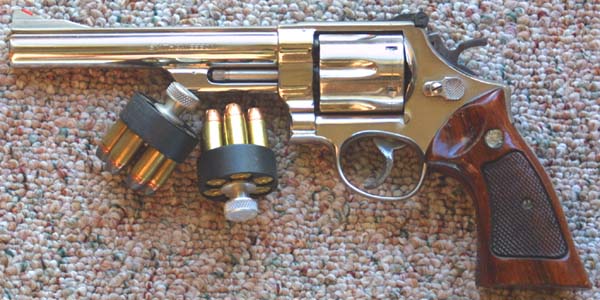

| Back to The Collection | Back to Home |

|
S&W M-29 | 
|
| Length Overall | Barrel Length | Weight | Caliber | Action Type | Magazine Capacity |
| 12" | 6.5" | 49.5 oz | .44 Mag | D.A. Revolver | 6 |
Do you feel lucky punk?
I apologize for this bit of foolishness, but I just had to say it. There
is not a man alive, who has seen a Dirty Harry movie, who would not do the
same thing, at least once, after having this revolver in his possession.
This is right up there with "You talkin' to me?" from the movie Taxi Driver,
which also featured a Model 29 44 magnum revolver. This is the gun that Clint
Eastwood carried as Harry Callahan. It soon became the gun that everyone
wanted to own, or at least to shoot. This gun was introduced in 1955, simply
as "The 44 Magnum". The name was changed to the Model 29, in 1957, when
S&W organized, and categorized it's entire line. The pistol itself is
built upon the highly regarded "N" frame, which is, appropriately, the largest
revolver frame that S&W produced at the time. Other weapons built on
this frame include the models 28 (357), 27 (357), 57 (41 Mag), 25 (45 ACP),
and the old M1917 (45 ACP). These guns are all, more or less, indistinguishable
from each other, without examination (though a bit of barrel taper is detectable
on the 357 Model 27), and comparison of the bore, and all of the parts will
interchange, with the exception of the barrel, and of the cylinder. The
Model 29 has been featured in other movies, but it's most memorable appearances
have been in the Dirty Harry series (6" and 8 3/8" blue), and in Taxi Driver
(8 3/8" blue). This was S&W's flagship handgun, for decades, and continues
to be one of it's top of the line revolvers. My personal model has the 6
1/2" barrel, which was the most popular offered on the stock gun. This is
the same as Harry's 6 1/2", and is a bit better choice for a magnum cartridge,
than the 4" (though not as good as the 8 3/8"). My gun is also nickel plated,
rather than blued. 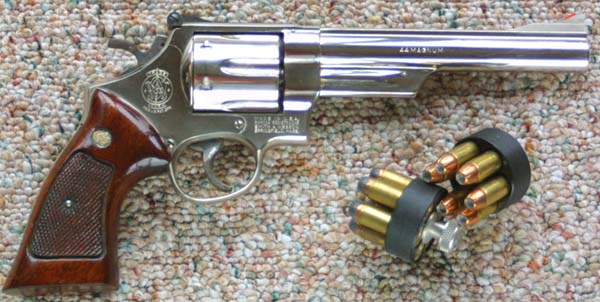 Though the 44 Magnum cartridge is mentioned separately
on it's own page, a brief summary follows. This cartridge was developed
as a result of experiments done by a number of handloaders. The leader,
and most highly regarded member of this group of handloaders was Elmer Keith.
He is thus credited with it's development. In 1955, S&W took some specially
heat treated revolvers, chambered them for a slightly lengthened version
of the 44 Special, and a legend was born. In order to avoid repeating myself
too much here, I direct the interested reader to my
section on the 44 Magnum.
Though the 44 Magnum cartridge is mentioned separately
on it's own page, a brief summary follows. This cartridge was developed
as a result of experiments done by a number of handloaders. The leader,
and most highly regarded member of this group of handloaders was Elmer Keith.
He is thus credited with it's development. In 1955, S&W took some specially
heat treated revolvers, chambered them for a slightly lengthened version
of the 44 Special, and a legend was born. In order to avoid repeating myself
too much here, I direct the interested reader to my
section on the 44 Magnum.The fit and finish of this gun are superb, as the photo shows. This is a heavy piece, and was considered to be ungainly, and burdensome to carry, back in the fifties, and sixties. Guns have grown larger, in the last few decades, in part because of the increase in handgun hunting. There are now several pistols which make the old N frame Smiths seem almost petite. The double action pull is smooth, crisp, and light, at least on my gun. The single action pull, is startlingly light, and crisp, and breaks without any warning; perfect. The gun was bought used, and I suspect that a previous owner may have had the action smoothed, or it may just be that the gun was well cared for, and properly broken in. In general, these guns are very stable platforms, for deliberate aimed fire. Single action shooting, with .44 special loads, can produce groups of 2". Double action work, particularly with magnum loads, can more than double this group size, at least for me. I suspect that there are few shooters out there who use rapid fire, double action with this gun. Shooting the 44 magnum cartridge out of this gun, single action, with a proper rest, can give me sub 2" groups; but I suspect that the gun is capable of even better accuracy than this, when in highly skilled hands. The model 29 became hugely popular, after the Dirty Harry movies, and Smith never did bring production up to a level to meet demand. At their peak of popularity, these guns were selling for almost triple what the suggested price was. I recall in the late seventies, When I bought my first model 29, they retailed for around $200; but you could not touch one for less than $600. The feeding frenzy ended with the introduction of double action .44 revolvers by several competitors, and the realization of many shooters, that the .44 was a bit more gun than they really wanted. With the introduction of the Ruger Blackhawk, as well as a number of other single action revolvers chambered for the 44, a large number of handgunners were able to sate their desire for a 44, without paying the ruinous prices being asked for the Model 29 during their Dirty Harry years. With the introduction of the Ruger Redhawk, as well as the introduction of the Dan Wesson 44, S&W had some real competition. Not only did their added numbers affect the market; but there was also the fact that these guns were stronger, and less expensive than the big S&W. In order to maintain their hold on the market, S&W intitally resorted to some cost cutting measures, so that they could lower the cost of the guns. They then took some steps to increase the strength of the Model 29. The Model 29 has an actual bore diameter of .429, giving just a bit more metal between the cylinders, than would be the case with a 45. This margin of strength As was true, during the filming of Dirty Harry, the M-29 is once again out of production, though the stainless steel version (M-629) is still being made. A 50th anniversary model was produced, in 2004; but I fear that this may be the future of the big N frame magnums --- limited editions, and commemoratives. There are currently no N frame revolvers being made in regular steel, and as far as I know, only the 629 (44), 657 (41), and 625 (45) are being made in stainless. The classic, big frame Smiths are becoming a thing of the past, with only the 629 being produced in any kind of quantity. They will be mourned. Dirty Harry
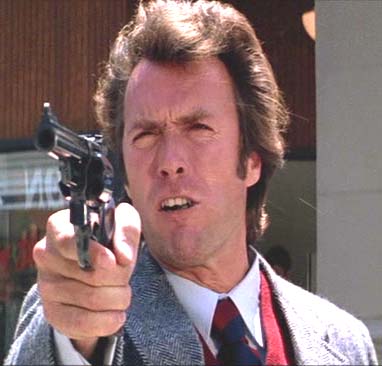 You can't read about the 44 Magnum, or the Model
29, without hearing a long dissertation on Dirty Harry. Many gun enthusiasts
tire of the hype, and of the wearisome tirades about how this movie made
the gun what it is today. This is similar to the relationship between the
Walther PPK, and the James Bond series of movies. For those who are fed up
with hearing about Dirty Harry, and for those who wish to hear more, I have
set the Dirty Harry commentary separate from that of the M-29 itself.
You can't read about the 44 Magnum, or the Model
29, without hearing a long dissertation on Dirty Harry. Many gun enthusiasts
tire of the hype, and of the wearisome tirades about how this movie made
the gun what it is today. This is similar to the relationship between the
Walther PPK, and the James Bond series of movies. For those who are fed up
with hearing about Dirty Harry, and for those who wish to hear more, I have
set the Dirty Harry commentary separate from that of the M-29 itself.There is some disagreement on whether a genuine .44 was actually used in these movies or not. It is rumored that the actual gun used during filming, was a model 57 (41 Magnum), because of the lack of production M-29's at the time the movie was being made. This could have been pulled off quite easily, for two reasons. The bore sizes of the two calibers are very close. The .44 Magnum is based on the .44 Special, which itself is based on the much older .44 Russian. This cartridge (the .44 Russian) was developed in the 1870's to compete with the .45 Long Colt. The actual bore size of all of these .44's is .429, rather than .44. The .41 Magnum is a much more recent cartridge, and has a bore size of .41, more closely reflecting it's name. The difference between the two bore sizes, is therefore only .019". This is approximately 1/50th of an inch. It is doubtful that most people could tell the difference, particularly on casual examination. There is also the fact that the three top of the line S&W magnum revolvers, are all built on the same frame, and all use the same cylinder, and barrel blanks. Other than the different borings of the barrels and cylinders, the guns are identical. It has also been said that a Model 25, in 45 A.C.P. was used, due to the more easy availability of 45 blanks. About the only thing that seems to be agreed upon, is that the gun used for filming was not a Model 29. So why might a different caliber been used, rather than the .44? The truth is that, previous to all of the hype generated by the Dirty Harry movies, the M-29, was just plain not popular. The gun was (and continues to be) big, heavy, unpleasant to shoot, and overpowered for defense. It's only real use would be for hunting larger animals, and hunting with a handgun was almost unheard of back in the fifties, and sixties. Many hunters had considered it to be inhumane. The Model 29 was always a gun of very limited numbers, bought by a small and specialized segment of the shooting public. Because of the relatively slow demand, production would sometimes stop, though the gun was never removed from the S&W catalog. At the time that Dirty Harry was being produced, the Model 29 was not even being made. Clint Eastwood has never commented on these rumors, and may not have known himself, what he was firing, so closely do these guns resemble each other. Movie guns are generally specially modified so that real ammunition can not chamber or fire in them, making the distinction between these, very similar guns, even more difficult to determine. Typically, movie guns fire 6 in 1 blanks, which make filming action seens quite a bit easier, as frequent reloading between takes is not required. Studio armourers handle all firearms, and all blank ammunition. What is known, is that Eastwood procured an actual .44 so that he could get a feel for what shooting the gun was like, to help him better play his part, but did not use this gun during filming. The gun he used, is said to have been made up specially from extra parts, and repair spares that were stocked by the factory. I have seen many "proofs" on both sides of this issue, and hope to take a trip down to the S&W museum, to verify. Emails to S&W have not yet recieved a satisfactory response.  Another difficulty, was in procuring a proper holster
for this gun. Detectives, and inspectors do not go around packing guns on
their hips like cowboys. The N
Another difficulty, was in procuring a proper holster
for this gun. Detectives, and inspectors do not go around packing guns on
their hips like cowboys. The NThe holster itself is deserving of some comment, as it was quite an advanced design, in it's day, and incorporated a number of new features, which still hold it in good stead today. The most significant was the use of a bit of spring steel to permit the gun to be securely held, while offering a very fast draw. This was done in combination with a, then new, open fronted holster design, producing what has come to be called the clamshell holster. Holsters have traditionally been designed to have the pistol pulled straight out of the top. This is a natural enough design; but offers certain disadvantages for the shoulder holster. The main disadvantage of a traditional top draw, in a shoulder holster, is that it tends to make the draw exaggerated, and very circular. This costs a great deal of speed, and can also make the gun liable to snag. The clamshell design allows the gun to pivot, and be drawn straight out. So great can this advantage be, that it also began to be incorporated into certain belt holsters. The clamshell design was incorporated into a number of latter shoulder holsters, most notably the popular Bianchi XP-1000 series; but never with the elegance of this groundbreaking model. Note that this holster features a cut out for the revolver cylinder, allowing it to be a bit thinner, and also giving the holster a better and more secure grip on the gun. Some latter models incorporated a pouch for speedloaders, in the side opposite the gun. In the Movies, Dirty Harry simply carried three speed loaders in his jacket pocket giving him a total of 24 rounds, inclusive of the cartridges loaded in the Revolver's cylinder. Due to the perversity of the collector mentality, these holsters are often more expensive than the guns which they carry. A genuine Dirty Harry holster can cost $500-$1000, if it is in pristine condition. The reason for this is pretty simple --- rarity. A Model 29 handgun is made to withstand the force of explosions taking place within it's cylinder. It is made from various sorts of alloyed steel, and is proof tested before leaving the factory. A holster is not. A holster is made from leather, or synthetic, and only needs to be strong enough to hold the weight of a gun, with a reasonable margin built in. Holsters rot, tear, and are sometimes lost. A gun owner will lovingly clean, oil, and carefully store his handguns, after use. A holster, on the other hand, will generally be removed, and tossed in a closet, or drawer. There is also some argument over what barrel length was used. This is a bit easier to answer. The 6 1/2" barrel was used in the first two movies, while the 8 38" barreled gun was used in the next. Just to complicate matters, the posters, and publicity art sometimes depicted longer barrels than those used on the movie guns. What needs to be kept in mind, when discussing such matters, is that these are movies. Things are done for effect here, and reality often takes a back seat. 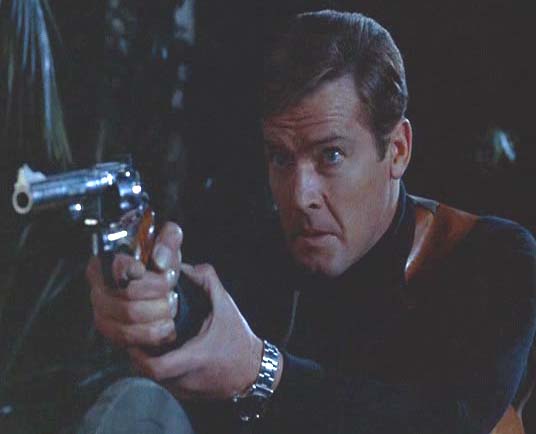
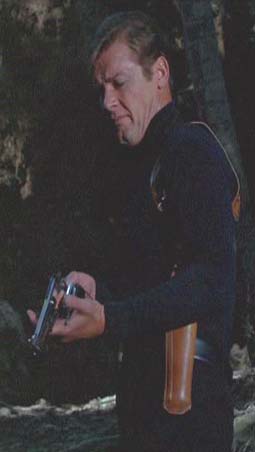 The 44 Magnum, and Model 29, were featured, or referred
to in a number of other movies; but their most famous appearances, outside
of Dirty Harry, were in the classic, Taxi Driver, and in the James Bond
movie, Live And Let Die. The gun featured in Live And Let Die was pretty
much identical to the one I own. This was the first Bond movie featuring
Roger Moore, who happens to be my least favorite of all of the Bonds. The
gun was used in a single scene, where Bond was to rescue Jane Semour from
the clutches of the evil dictator Kananga, as she was about to be sacrificed
in a voodoo ritual. The Model 29 had thus achieved such cult status that,
during the seventies, even James Bond had to use one.
The 44 Magnum, and Model 29, were featured, or referred
to in a number of other movies; but their most famous appearances, outside
of Dirty Harry, were in the classic, Taxi Driver, and in the James Bond
movie, Live And Let Die. The gun featured in Live And Let Die was pretty
much identical to the one I own. This was the first Bond movie featuring
Roger Moore, who happens to be my least favorite of all of the Bonds. The
gun was used in a single scene, where Bond was to rescue Jane Semour from
the clutches of the evil dictator Kananga, as she was about to be sacrificed
in a voodoo ritual. The Model 29 had thus achieved such cult status that,
during the seventies, even James Bond had to use one. |